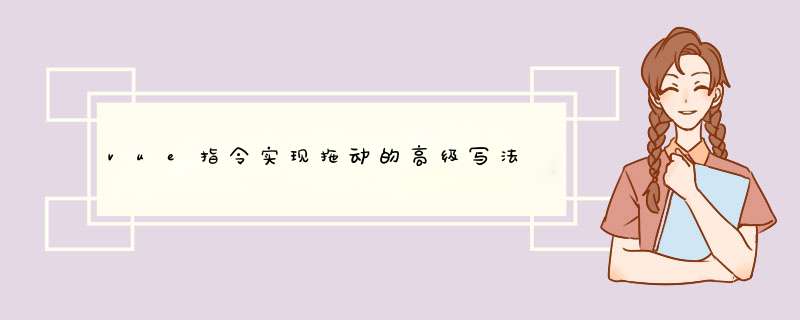
不熟悉vue自定义指令看这里: https://cn.vuejs.org/v2/guide/custom-directive.html
vue指令实现拖动方法很方便也挺简单,但是网上大部分的教程代码,一般都是把代码全部写一个方法里面,代码不够美观,代码逻辑也不太清晰,不推荐这种写法,比如下面这样:
Vue.directives: { drag: { // 使用bind会有可能没有渲染完成 inserted: function(el,binding,vnode) { const _el = el; //获取当前元素 const ref = vnode.context.$refs[binding.value]; // 判断基于移动的是哪一个盒子 const masterNode = ref ? ref : document; // 用于绑定事件 const masterBody = ref ? ref : document.body; // 用于获取高和宽 const mgl = _el.offsetleft; const mgt = _el.offsettop; const maxWIDth = masterBody.clIEntWIDth; const maxHeight = masterBody.clIEntHeight; const elWIDth = _el.clIEntWIDth; const elHeight = _el.clIEntHeight; let positionX = 0,positionY = 0; _el.onmousedown = e => { //算出鼠标相对元素的位置,加上的值是margin的值 let disX = e.clIEntX - _el.offsetleft + mgl; let disY = e.clIEntY - _el.offsettop + mgt; masterNode.onmousemove = e => { //用鼠标的位置减去鼠标相对元素的位置,得到元素的位置 let left = e.clIEntX - disX; let top = e.clIEntY - disY; // 绑定的值不能滑出基于盒子的范围 left < 0 && (left = 0); left > (maxWIDth - elWIDth - mgl) && (left = maxWIDth - elWIDth - mgl); top < 0 && (top = 0); top > (maxHeight - elHeight - mgt) && (top = maxHeight - elHeight - mgt); //绑定元素位置到positionX和positionY上面 positionX = top; positionY = left; //移动当前元素 _el.style.left = left + "px"; _el.style.top = top + "px"; }; // 这里是鼠标超出基于盒子范围之后再松开,会监听不到 document.onmouseup = e => { masterNode.onmousemove = null; document.onmouseup = null; }; }; } } }
这里介绍一种比较方美观,逻辑清晰的写法,代码如下:
Vue.directive(‘drag‘,{ bind (el,binding) { el.style.cursor = ‘move‘ el.style.position = ‘fixed‘ el.mousedownPoint = { x: 0,y: 0 } // bind 改变函数内部 this 指向,让 this 指向 el // el.handleMouseup,el.handleMousemove,el.handleMousedown 这三个可以是其他的全局变量 el.handleMouseup = handleMouseup.bind(el) el.handleMousemove = handleMousemove.bind(el) el.handleMousedown = handleMousedown.bind(el) el.addEventListener(‘mousedown‘,el.handleMousedown) document.body.addEventListener(‘mouseup‘,el.handleMouseup) document.body.addEventListener(‘mousemove‘,el.handleMousemove) },unbind (el) { document.body.removeEventListener(‘mouseup‘,el.handleMouseup) document.body.removeEventListener(‘mousemove‘,el.handleMousemove) }});
const handleMousedown = function (e) { // 这里的this被bind改变了,是el // 这里的e是 MouseEvent 对象 const initialposition = this.getBoundingClIEntRect() this.style.wIDth = initialposition.wIDth + ‘px‘ this.position = { left: initialposition.left,top: initialposition.top } this.readyToMove = true this.mousedownPoint.x = e.screenX this.mousedownPoint.y = e.screenY } const handleMousemove = function (e) { if (!this.readyToMove) return false const position = this.position position.left = position.left + e.screenX - this.mousedownPoint.x position.top = position.top + e.screenY - this.mousedownPoint.y this.mousedownPoint.x = e.screenX this.mousedownPoint.y = e.screenY this.style.left = position.left + ‘px‘ this.style.transform = ‘none‘ this.style.marginleft = 0 this.style.margintop = 0 this.style.top = position.top + ‘px‘ this.style.bottom = ‘auto‘ this.style.right = ‘auto‘ } const handleMouseup = function (e) { this.readyToMove = false } 这种写法主要利用了bind的特性,回一个新的函数,并且这个函数的 this 已经被改成我们想要的 this,推荐这种写法。
总结以上是内存溢出为你收集整理的vue指令实现拖动的高级写法全部内容,希望文章能够帮你解决vue指令实现拖动的高级写法所遇到的程序开发问题。
如果觉得内存溢出网站内容还不错,欢迎将内存溢出网站推荐给程序员好友。
欢迎分享,转载请注明来源:内存溢出

 微信扫一扫
微信扫一扫
 支付宝扫一扫
支付宝扫一扫
评论列表(0条)